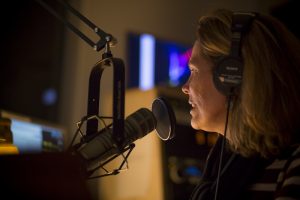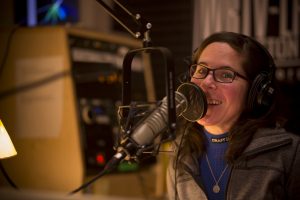In November of 2017, after 4 years of planning and working through piles of red tape, WBTV-LP officially went on air. Bill Simmon, WBTV-LP’s Station Manager, talked with us about how it got to where it is today.
In 2000 a group from a local non-profit called VCAM (Vermont Community Access Media) with it’s sister organization RETN (Regional Educational Television Network) decided the next step for them would be to create a community radio station. Since VCAM’s mission is to promote public dialog by enabling easy access to an expanding world of media, it was easy for them to see that it was a natural fit for their organization. From the very beginning the community was involved. The already existing radio station WOMM-LP, which mainly focuses on music from the Burlington area, helped to gain perspective about the communities interest in community based radio. Simmon explains that in 2013 “a small group of community members approached us and they thought there was room in our community for another community radio station and we agreed, and we knew we already had this preexisting interest in community radio and so with their help we formed what we called the red tape committee and began the process of applying for a construction permit for an LPFM.”
Facilitating Quality Radio
Simmon admits that Burlington is “blessed” that with only 100,000 people in the greater metropolitan area there are two community stations as well as college radio stations and just an hour away is Goddard College’s WGDR. So with all these stations surrounding WBTV-LP what is their focus? “We identified what we call the 4 pillars and they are in no particular order, free speech, education and learning, civic engagement, and diversity of voices. So those concepts sort of form the tent polls, and everything else, the programming vision, the mission statement, the idea of what the station is, all happens at the community level through committee work but within those four tent polls.” states Simmon. Since the community asked for this station it only makes sense that they focus on original programming and importantly programming that is relevant to the community.
Simmon explains that up till now their priority has been to train local producers so they can populate their schedule with as much locally produced content as possible. When a show is approved for a spot on the schedule Simmon explains, “then we have a fairly lengthy training process. [This is] one of the things that sets us apart from some of the other stations… because we are a community center and we do workshops and trainings in media already… we have expanded to do a lot with radio and podcasting so people can go from 0 to 60 pretty quickly.”
Even though there are multiple stations within the area, Simmon states, “I never ever felt like what we were doing was redundant in any way.” He goes on to explain, “we are more focused on a more general umbrella with emphasis on lots of training, trying to make good radio as opposed to making just radio. I think that’s helping to differentiate us and we try to have our trainings available to everybody in the area. So, if someone is doing a show at the college radio station and they want to come and take a workshop and up their game and make better radio at the University of Vermont we want them to come here and learn that stuff and participate and get involved… we want to help raise the bar in terms of quality radio programming in the area that way.”
Current Programming
WBTV-LP currently airs a large variety of original local programming including, Vermont Film Essentials where classic movies such as Grapes of Wrath and The African Queen are reviewed and analyzed by two local producers. Morella Devost hosts, Thrive with Morella, a show that includes discussions and interviews concerning new age health. More shows include, Steam Lab which discusses science, technology, engineering, art and math. Write the Book, hosted by Shelagh Shapiro, a show that interviews authors about their books and writing experience. Select Cuts where local designers play music that inspires their designs, and The Quiet Storm, a smooth jazz show. These are just a few programs that are locally broadcast.
Along with radio broadcast, show producers can also air their programs as television shows at the same time. For instance Thrive with Morella is part of a “simulcasting” project that WBTV-LP is involved in. Every Monday at 2pm she is able to simultaneously broadcast her program on radio, television, and facebook live.
Future Events
Because of the success with programmer development, WBTV-LP plans to start switching gears to listener development. With a combined force of local programming they have built up and access to syndicated programming through Pacifica Network, Simmon hopes to have their programming schedule filled from 7am to Midnight, seven days a week. With a full schedule they will be confident to start outreach for listeners.
Simmon says that really none of the people who were involved in building the station really knew how to build one. “It’s really interesting the learning curve from going from 0 to 60…” he relates. He went on to admit that even though it may have taken a little longer to build the station, because of how much volunteer involvement they had, it really added to the flavor of their station. This year they are going to be celebrating the 1st anniversary of WBTV-LP in September, along with the states biggest art festival, The South End Art Hop.



